
How Much Would Older Workers Respond to an EITC Expansion?
The brief’s key findings are:
- The Earned Income Tax Credit (EITC) encourages low-income people with kids to work – those without kids get a much smaller credit.
- Previous EITC research has focused on younger households, but some analysts suggest an expanded childless credit could boost work among near retirees.
- This study finds that raising the EITC by $1,000 would produce a modest rise in employment among single women ages 55-64.
- However, this impact is much smaller than that for younger single women, perhaps because older women have higher earnings or more health limitations.
- Thus, an expanded EITC would primarily benefit younger workers, though with a positive side effect for at least some older workers too.
Introduction
The Earned Income Tax Credit (EITC) – a refundable credit that rises with earnings up to a point before phasing out – is one of the federal government’s largest poverty reduction programs. The EITC’s design – which yields no benefit to non-workers – has been found to encourage employment among lower-income individuals. This rare combination of poverty reduction and work encouragement means that expansion of the EITC has long enjoyed bipartisan support. One of the most common suggestions for expansion is an increase in the size of the credit for childless households, which is currently so small that few people use it.1 Indeed, a tripling of the childless benefit was part of a temporary package enacted during the COVID pandemic.2
An expansion of the childless benefit is usually framed as a boon for the well-being of younger, low-income workers. However, some have pointed out that another benefit may be to encourage low-income individuals approaching retirement – who are often at risk of inadequate retirement resources – to extend their careers.3 Since the vast majority of workers near retirement – defined here as ages 55-64 – do not have dependent children, they would benefit from such an expansion. However, because the current EITC is used mainly by those with children, no research has focused on how older individuals might respond to any expansion. But, roughly 15 percent of individuals near retirement do have dependent children, and this brief uses them as a base for an analysis of how older individuals responded to past expansions relative to their younger counterparts.4
The discussion proceeds as follows. The first section provides background on the EITC. The second section discusses the methodology used to explore the impact of EITC expansions on older workers, and the third section discusses the results. The final section concludes that while past EITC expansions likely have encouraged some older workers to extend their careers, the effect is significant just for single women and only at a third the rate of their younger counterparts. Hence, expansions of the childless credit should be considered mainly in the context of younger workers, but with the recognition that such an expansion will likely encourage at least some older individuals to work longer.
Background on the EITC
The EITC started as a small, temporary provision in 1975, but expansion over the years has made it one of the biggest federal antipoverty policies.5 The credit is refundable, so that it can increase the income available to a household instead of simply reducing its tax burden. The basic structure of the EITC is illustrated in Figure 1, using the 2019 rules as an example (the analysis stops that year to avoid temporary changes in EITC rules during COVID). The figure shows four prominent features of the program. First, as mentioned above, the EITC is very small for families without dependent children.6 Second, the EITC increases with the number of dependent children. Third, the credit increases as a household goes from no earned income up to a moderate income before plateauing. And fourth, the credit is gradually phased out as earned income increases. Combined, these four features mean that the EITC currently affects primarily low-income households with children, often single mothers.
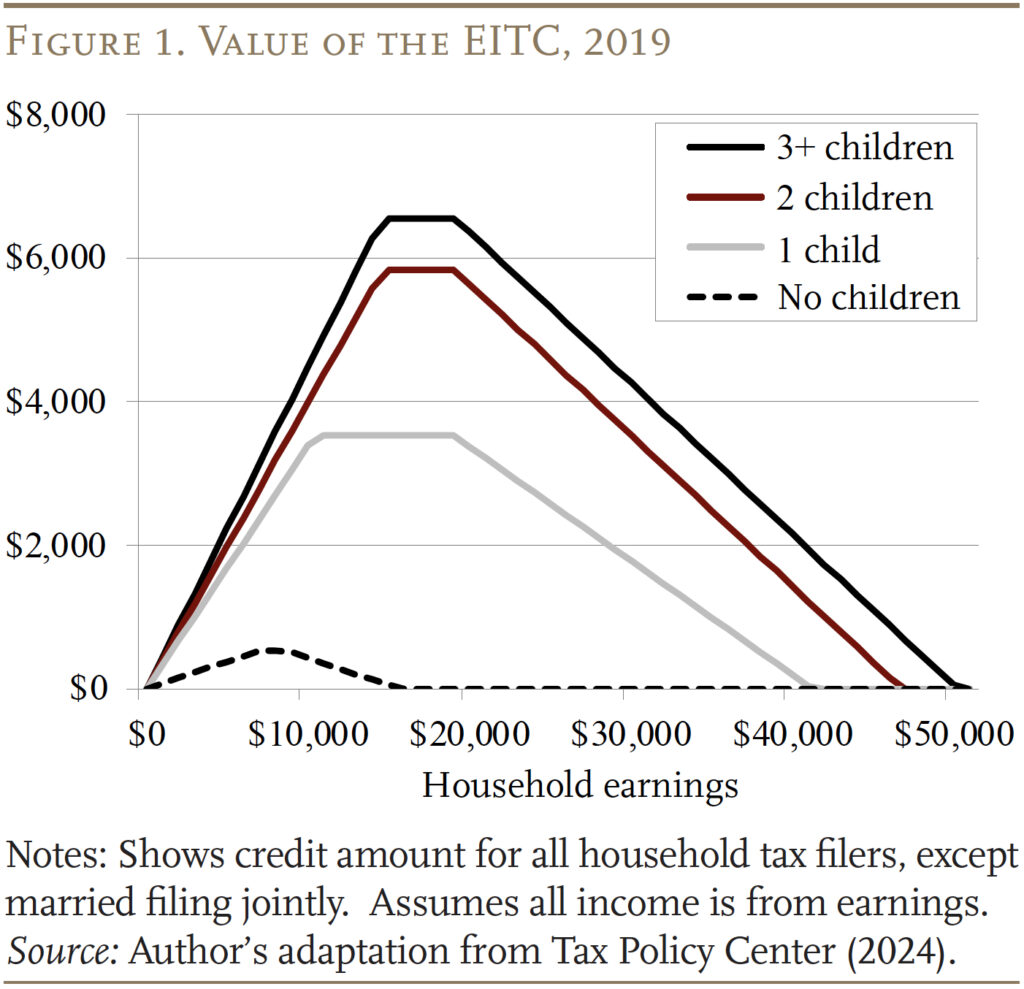
Because the EITC only applies to workers, it aims to encourage people to go from not working to working. Research on the topic strongly suggests that the policy achieves this goal, especially for younger single parents.7 But, little research to date has focused on the EITC’s effect on older workers, even though non-EITC-based research has suggested that they may respond differently than younger individuals to tax incentives.8 The reason for this lack of focus is simple. Just 15 percent of individuals ages 55-64 still have dependent children. Still, even though small in proportion, this group who do have dependent children can serve as a base for research.
Methodology
This brief uses the Current Population Survey (CPS) from 1988-2019 and follows the methodology of Bastian and Jones (2021). That paper exploits variation in the size of the EITC both over time and across households with different numbers of dependent children. Figure 2 shows this variation and illustrates two trends. First, in real terms, the maximum size of the EITC credit has increased since the 1980s, with discrete jumps in 1991, 1994, and 2009. Second, the maximum credit has varied more by the number of children in a household as families with more dependent children were given larger benefits relative to those with fewer.
The analysis compares the employment of individuals with different access to the EITC, using the maximum credit that each group can receive as a proxy for program generosity. Although Figure 2 shows that large jumps in EITC benefits occur just a few times, these changes introduce substantial variation in the maximum benefit across households. For example, in 1987, households with dependent children received a modest maximum credit of $1,915 (in 2019 dollars), regardless of their family size. By 1996, that number for households with a single child had nearly doubled to $3,513, and households with two or more children had seen their maximum benefit triple to $5,796. Further separation occurred for households with three or more children in 2009, when they received a nearly 20-percent boost in their maximum benefit. Across the sample considered here, the average maximum EITC is $2,697, with a standard deviation of $2,334.
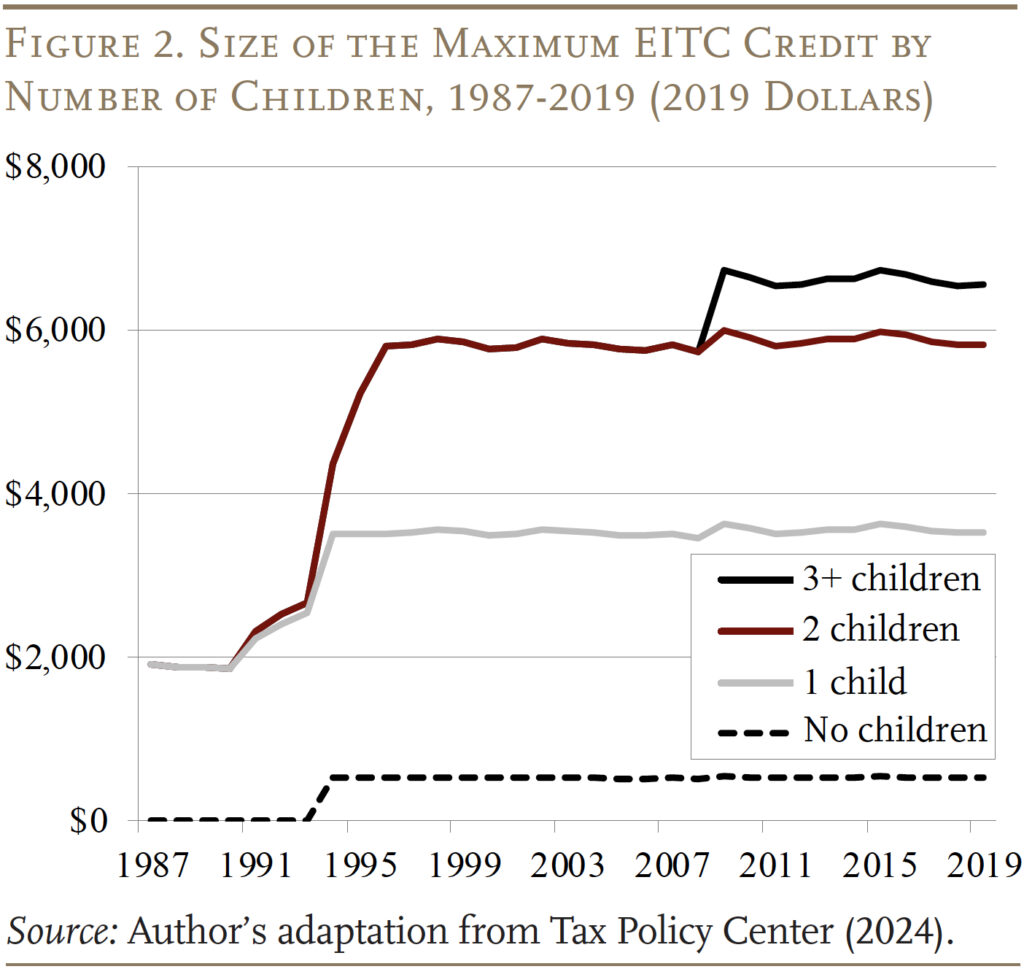
A regression is used to compare the employment rate of individuals facing different maximum EITC benefits, controlling for number of children, education, race, age, state of residence, and year observed. Regressions are run only on those with a high school degree or less, as they are most likely to be impacted by any expansion of the EITC based on their lower earnings levels.
Prob(Employment) = f(maxEITC, children, race, education, age, year, state of residence)
This approach takes advantage of the fact that households with the same number of children face different benefits at different times, while households at the same point in time face different benefits based on their number of children. So, for example, to the extent that individuals in households with three versus one dependent child work less in 1987, the regression asks: did that difference change when a three-child household received a comparatively larger EITC benefit in 2010? Using this approach, Bastian and Jones report that the EITC significantly increases the employment rate of women, with the effect concentrated among single women.9
The question here is, does this result differ based on the age of the individual? Thus, the analysis is performed separately for workers ages 25-54 and 55-64. Because the effects of the program likely differ for women relative to men (who tend to earn more), the analysis is also done separately by gender. And, because the EITC can impact single versus married households differently, the analysis is further separated by marital status.10
Results
Before turning to the regression results, Table 1 highlights key characteristics of the sample by age. The older individuals are less likely to be employed, to have dependent children, and to be Hispanic, and slightly more likely to be high school dropouts.
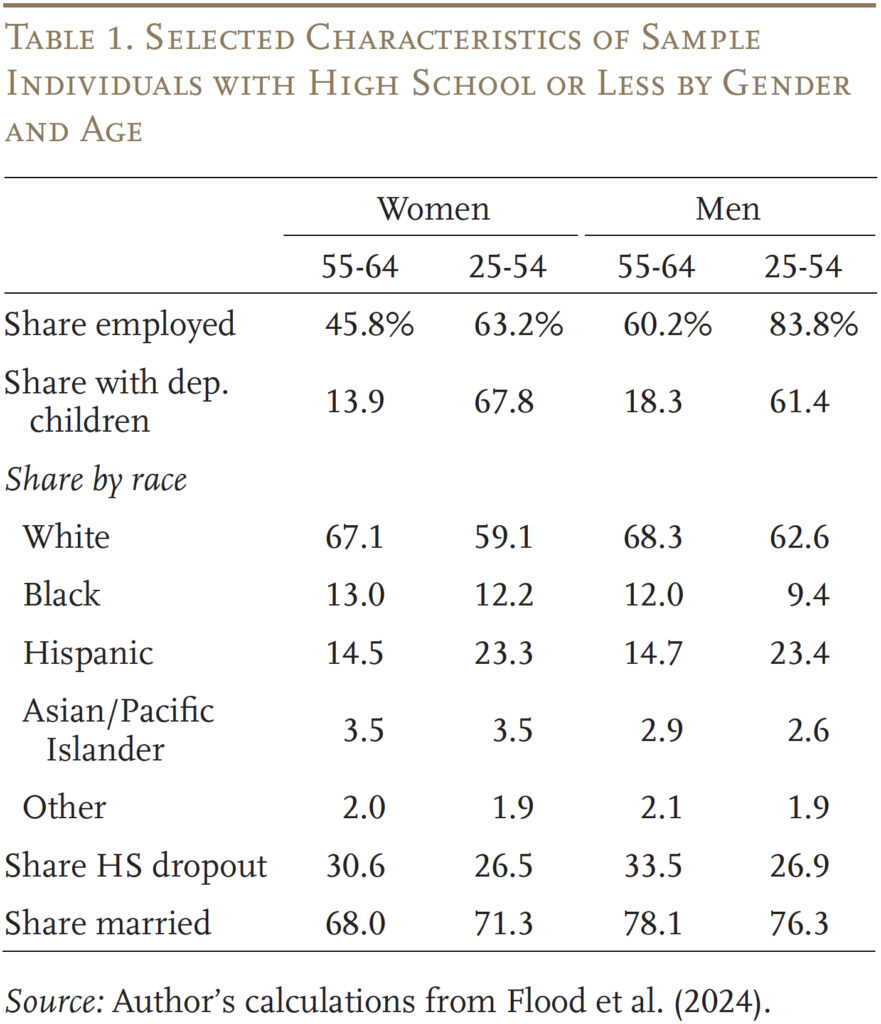
Figure 3 highlights the main results of the regression analysis, with full results in the Appendix. The figure shows how the various groups’ likelihood of employment is expected to respond to a $1,000 increase in the highest EITC benefit available to them. For women, the results suggest that older singles would be expected to increase their probability of working by 1.5 percentage points, which is statistically significant. However, the size of the effect is substantially smaller than for younger single women, whose employment would be expected to increase by 5.5 percentage points. This result may stem from the fact that older women have more work experience and higher earnings and so are less affected by expansions. Or, the lower effect could reflect more health limitations among this older group.11
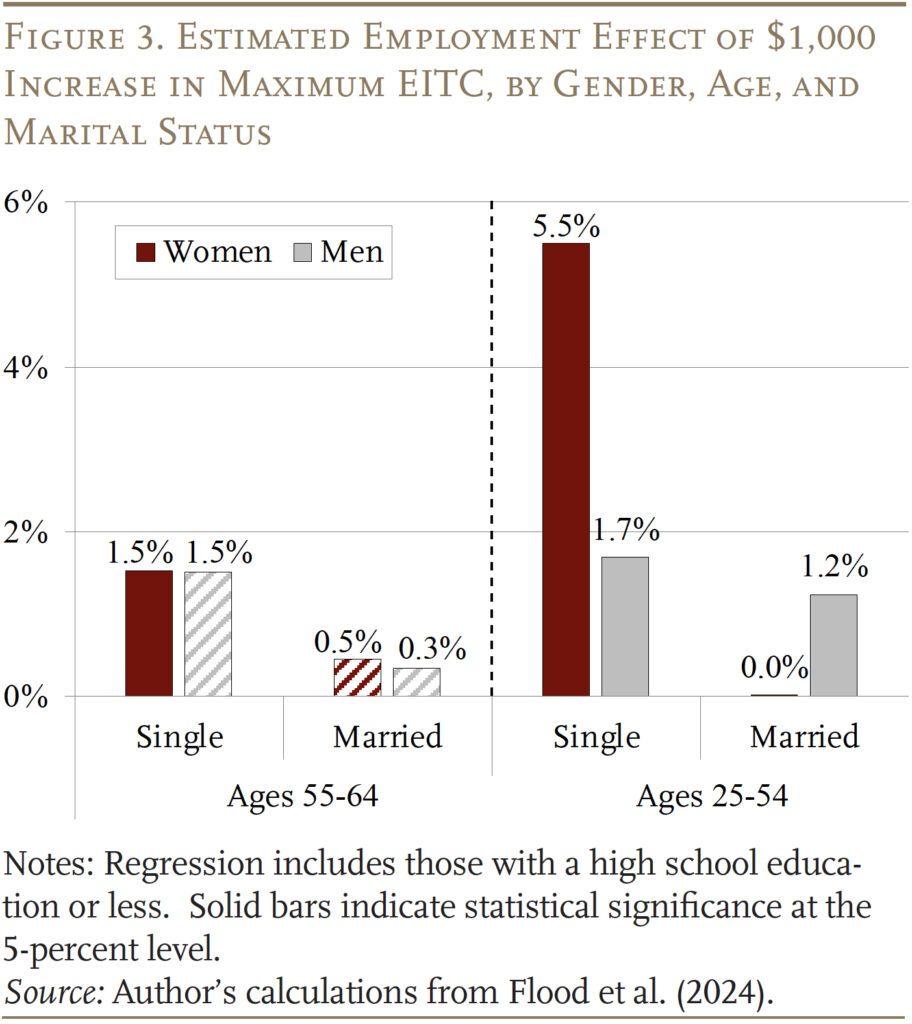
The effect for older single men is similar in magnitude to single women, but insignificant statistically. This insignificance is likely because the sample of single men ages 55-64 is just 60 percent the size of single women of this age, both due to the higher mortality of men and the (related) fact that men in this age bracket are more likely to be married. Younger single men are significantly affected but at a lower rate than younger single women, again likely due to their higher earnings.
Married women in both age brackets are not predicted to be significantly affected. Such a finding is common for younger women at least, as married couples often earn too much to qualify for even the expanded versions of the EITC. Plus, if a woman has lower potential earnings than her husband, he may be the one to choose to work for wages and claim the EITC. Indeed, a positive significant effect is found for younger married men. Older married men seem not to be affected, likely because their higher earnings often push them out of EITC eligibility regardless of whether the size of the credit expands.
Conclusion
Expansion of the EITC – and in particular the childless worker benefit – is one policy that could encourage older individuals to work longer. The results here suggest that expanding the EITC would likely have a statistically significant impact on some older individuals’ employment. But, that impact is most likely to occur for older single women – who represent just 20 percent of those ages 55-64 – and at a rate just one-third that of similar, younger individuals. While this analysis is based primarily on expansions to those with children, it provides some of the first evidence that older workers may be less responsive to the EITC than their younger counterparts.
That said, it is clear from this analysis and others like it that EITC expansion has a considerable effect on the labor supply of younger workers and with a positive side effect: at least some older workers are likely to enter the labor force. These positive effects on employment, which reduce poverty and dependence on other government programs, may be reason enough to support an expansion of the policy.
References
Alpert, Abby and David Powell. 2014. “Estimating Intensive and Extensive Tax Responsiveness: Do Older Workers Respond to Income Taxes?” Working Paper WR-987. Santa Monica, CA: The RAND Corporation.
Bastian, Jacob E. 2020. “The Rise of Working Mothers and the 1975 Earned Income Tax Credit.” American Economic Journal: Economic Policy 12(3): 44-75.
Bastian, Jacob E. and Maggie R. Jones. 2021. “Do EITC Expansions Pay for Themselves? Effects on Tax Revenues and Government Transfers.” Journal of Public Economics 196: 104355.
Breunig, Robert V. and Andrew Carter. 2018. “Do Earned Income Tax Credits for Older Workers Prolong Labor Market Participation and Boost Earned Income? Evidence from Australia’s Mature Age Worker Tax Offset.” Working Paper 2018-15. Canberra, AU: Tax and Transfer Policy Institute.
Congressional Research Service. 2018. “The Earned Income Tax Credit (EITC): A Brief Legislative History.” CRS Report R44825. Washington, DC.
Crandall-Hollick, Margot, Nikhita Airi, and Richard C. Auxier. 2024. “How the American Rescue Plan’s Temporary EITC Expansion Impacted Workers Without Children.” Tax Policy Center Brief. Washington, DC: Urban Institute and Brookings Institution.
Eissa, Nada and Hilary Williamson Hoynes. 2004. “Taxes and the Labor Market Participation of Married Couples: the Earned Income Tax Credit.” Journal of Public Economics 88(9-10): 1931-1958.
Flood, Sarah, Miriam King, Renae Rodgers, Steven Ruggles, J. Robert Warren, Daniel Backman, Annie Chen, Grace Cooper, Stephanie Richards, Megan Schouweiler, and Michael Westberry. 2024. IPUMS CPS: Version 12.0 [dataset]. Minneapolis, MN: IPUMS.
Laun, Lisa. 2017. “The Effect of Age-targeted Tax Credits on Labor Force Participation of Older Workers.” Journal of Public Economics 152: 102-118.
Maag, Elaine. 2018. “Tax Reform 2.0 Should Expand Childless EITC to Reduce Poverty.” Tax Policy Center TaxVox. Washington, DC: Urban Institute and Brookings Institution.
Meyer, Bruce D. and Dan T. Rosenbaum. 2001. “Welfare, the Earned Income Tax Credit, and the Labor Supply of Single Mothers.” Quarterly Journal of Economics 116(3): 1063-1114.
Moulton, Jeremy G., Alexandra Graddy-Reed, and Lauren Lanahan. 2016. “Beyond the EITC: The Effect of Reducing the Earned Income Tax Credit on Labor Force Participation.” National Tax Journal 69(2): 261-284.
Munnell, Alicia H. 2018. “Want People to Keep Working Longer? Expand the Earned Income Tax Credit.” (November 14). New York, NY: MarketWatch.
Tax Policy Center. 2024. “EITC Parameters.” Statistics. Washington, DC: Urban Institute and Brookings Institution.
Yin, Yimeng, Anqi Chen, and Alicia H. Munnell. 2024. “The National Retirement Risk Index: An Update from the 2022 SCF.” Issue in Brief 24-5. Chestnut Hill, MA: Center for Retirement Research at Boston College.
Appendix
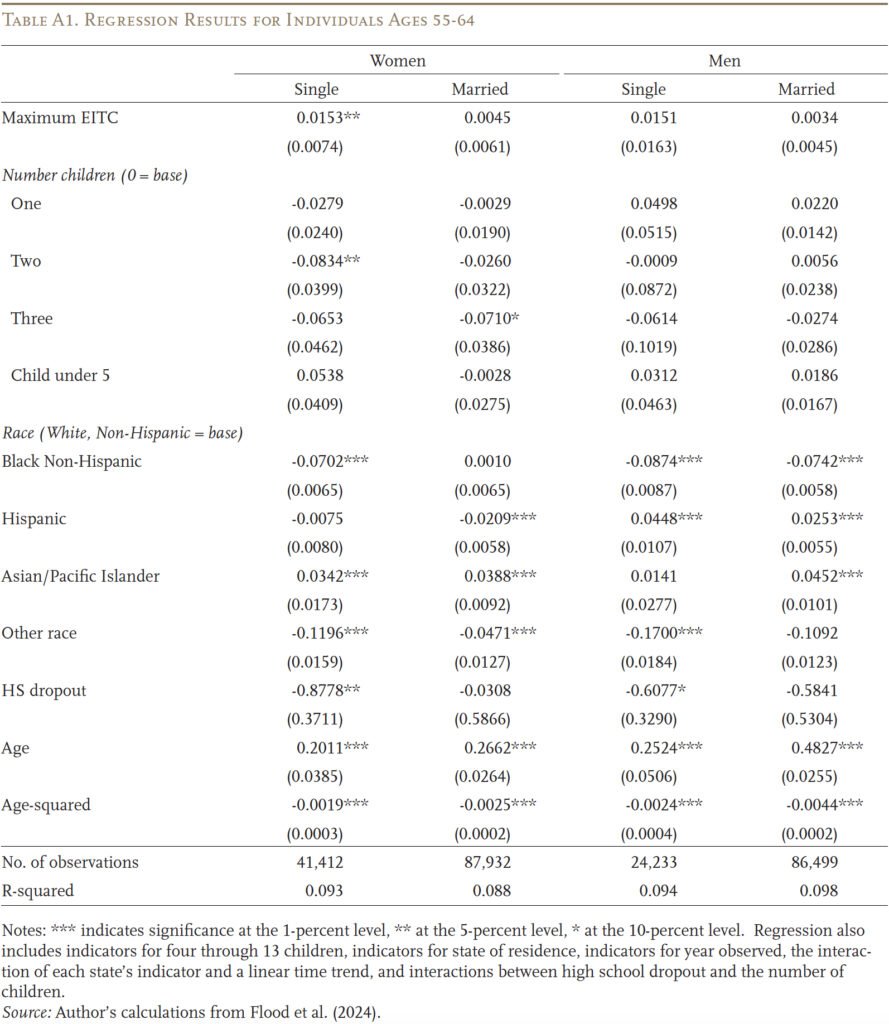
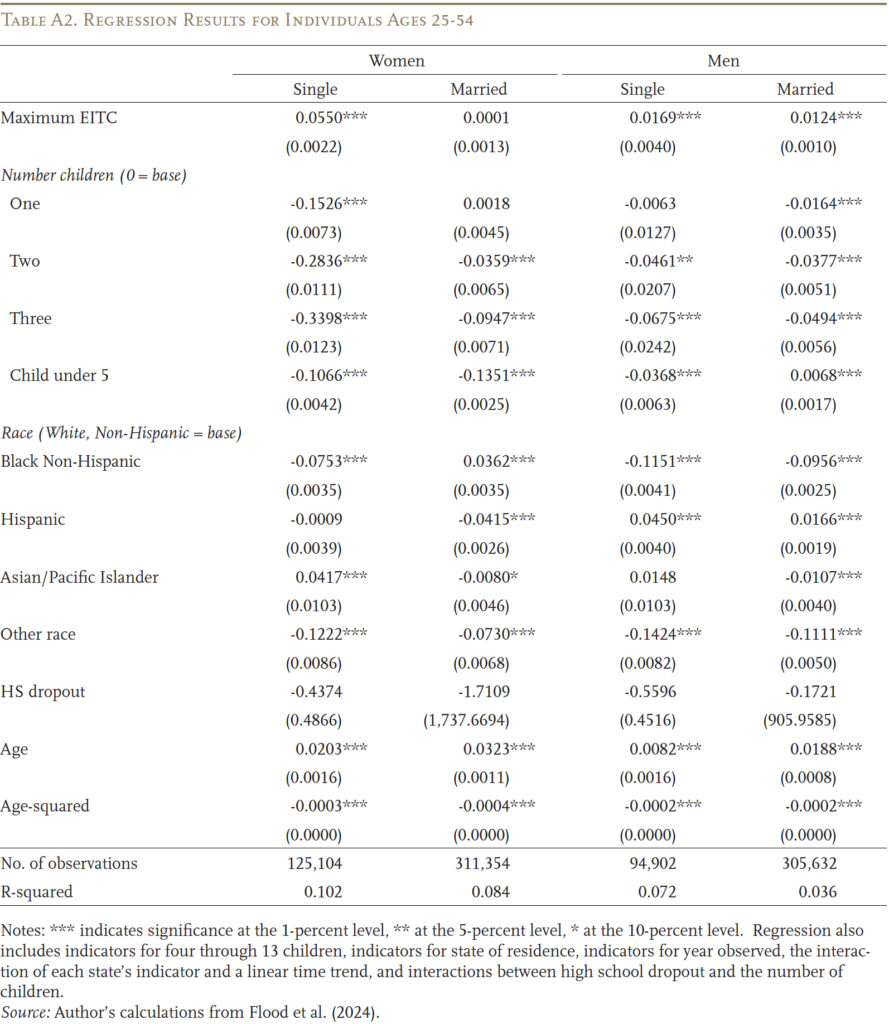
Endnotes
- For example, in 2014, President Obama and House Speaker Paul Ryan each proposed roughly doubling the EITC for childless households. See Maag (2018) for evidence that few people currently use the EITC for childless households. ↩︎
- See Crandall-Hollick, Airi, and Auxier (2024) for evidence that this expansion greatly increased the number of individuals using the childless credit. ↩︎
- For example, see Munnell (2018) for the suggestion that the EITC could help lower-income, older individuals. See Yin, Chen, and Munnell (2024) who find that low-income workers are more likely to be at risk of inadequate retirement income. ↩︎
- The paper is Bastian and Jones (2021), which is discussed in more detail in the methodology section. ↩︎
- Sizable increases in the credit occurred in 1991, 1994, and 2009. For an excellent legislative history, see Congressional Research Service (2018). ↩︎
- The only exception was the brief but sizable expansion during COVID that applied only for 2021. ↩︎
- See Bastian and Jones (2021), Bastian (2020), Moulton, Graddy-Reed, and Lanahan (2016), or Meyer and Rosenbaum (2001) for examples of various approaches that illustrate this point. The result is less clear for married couples. Eissa and Hoynes (2004), for example, find that the EITC may discourage work among married couples because the phase-out of benefits acts as a tax. ↩︎
- Perhaps the closest U.S. study is Alpert and Powell (2014), who simulate the effect of expanding the EITC to older workers and find perhaps a larger responsiveness of older than younger workers. But their estimates are based on responses to a change in the income tax, and income taxes target a very different population than the EITC. A few international studies look at programs similar to the EITC and generally see a small to moderate impact on labor supply (e.g., Breunig and Carter (2018) in Australia and Laun (2017) in Sweden). ↩︎
- The Bastian and Jones (2021) approach and the approach here also include considerable interactions between variables to ensure effects are due to EITC variation and not other sources. For example, a linear time trend is interacted with number of children to ensure that employment has not simply become easier or harder over time in a way that appears attributable to an expanding EITC. ↩︎
- Indeed, Bastian and Jones (2021) find that EITC expansions may decrease employment among married women, as working could push their household out of eligibility for the credit if the second earner’s wages are high enough. ↩︎
- Data on health are only available in more recent years of the CPS and thus are not included in this analysis. ↩︎







